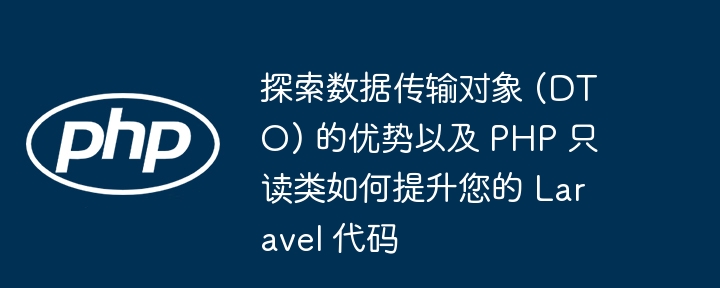探索数据传输对象 (DTO) 的优势以及 PHP 只读类如何提升您的 Laravel 代码
来源:dev.to
时间:2024-07-30 08:06:45 136浏览 收藏
学习知识要善于思考,思考,再思考!今天golang学习网小编就给大家带来《探索数据传输对象 (DTO) 的优势以及 PHP 只读类如何提升您的 Laravel 代码》,以下内容主要包含等知识点,如果你正在学习或准备学习文章,就都不要错过本文啦~让我们一起来看看吧,能帮助到你就更好了!

在现代 web 应用程序开发中,高效、安全地管理和传输数据至关重要。对此过程有显着帮助的一种设计模式是数据传输对象 (dto)。这篇文章将深入探讨使用 dto 的优势,特别是在 laravel 应用程序中,并展示 php 8.2 只读类如何进一步增强其优势。
什么是数据传输对象 (dto)?
数据传输对象(dto)是一个简单的对象,旨在在进程或系统之间传输数据。与典型的模型或实体不同,dto 不受业务逻辑的影响。它们封装数据,提供一种清晰且结构化的方式在应用程序的不同层或不同系统之间传输信息。
dto模式
dto 模式用于在软件应用程序内的不同子系统之间传输数据。使用 dto 的主要目标是最大限度地减少方法调用的数量、聚合必要的数据并提供结构化方法来管理数据转换和验证。
使用 dto 的好处
关注点分离: dto 将业务逻辑与数据表示分离,从而产生更清晰、更易于维护、更易于理解的代码。
数据验证: dto 允许在其他应用程序层处理数据之前对数据进行验证,确保仅使用有效数据。
一致性: 通过提供一致的数据传输结构,dto 简化了来自各种来源的数据的管理和处理。
安全: dto 可以通过控制哪些数据可访问和可修改来保护您的应用程序免受未经授权的数据操纵。
测试: 由于 dto 是没有嵌入业务逻辑的简单对象,因此它们更容易模拟和测试。
转换: dto 有助于将数据转换为不同应用层所需的格式。
-
不变性: dto 通常提倡不变性,这意味着一旦创建,它们的状态就无法更改。此功能带来了几个优点:
- 可预测性: 不可变对象是可预测的并且更容易推理,因为它们的状态在创建后保持不变。
- 线程安全: 不变性本质上支持线程安全,简化并发处理。
- 调试: 使用不可变对象进行调试更容易,因为它们的状态保证在整个生命周期中保持不变。
php 8.2 和只读类
在 php 8.2 中,只读类的引入增强了 dto 的使用。只读类无需将属性显式定义为只读,从而简化了 dto 实现。以下是 php 8.2 的只读类如何改进 dto:
- 简化代码:只读类自动使属性不可变,减少样板代码并提高清晰度。
- 增强的安全性:通过确保属性一旦设置就无法修改,只读类增强了数据完整性和安全性。
- 提高可维护性: 使用只读类可以生成更干净、更易于维护的代码,因为数据的不变性是由语言本身强制执行的。
示例:在物业管理系统中使用 dto
让我们考虑一个属性管理系统,其中属性可以来自各种来源,例如 api 和 csv 导入。我们可以使用 dto 创建属性模型、订阅、资产等,确保数据在整个应用程序中一致并经过验证。
定义 propertydto
首先,我们定义一个propertydto类:
app/dto/propertydto.php
namespace app\dto;
/**
* class propertydto
*
* represents a data transfer object for property data.
*/
readonly class propertydto extends abstractdto
{
/**
* the name of the property.
*
* @var string
*/
public string $name;
/**
* the address of the property.
*
* @var string
*/
public string $address;
/**
* the price of the property.
*
* @var float
*/
public float $price;
/**
* the subscription status of the property, if applicable.
*
* @var string|null
*/
public ?string $subscription;
/**
* the list of assets associated with the property.
*
* @var array|null
*/
public ?array $assets;
/**
* set the properties from a model instance.
*
* @param $model the model instance.
* @return $this
*/
public function setfrommodel($model): self
{
$this->name = $model->name;
$this->address = $model->address;
$this->price = $model->price;
$this->subscription = $model->subscription;
$this->assets = $model->assets;
return $this;
}
/**
* set the properties from api data.
*
* @param array $data the api data.
* @return $this
*/
public function setfromapi(array $data): self
{
$this->name = $data['property_name'];
$this->address = $data['property_address'];
$this->price = $data['property_price'];
$this->subscription = $data['subscription'] ?? null;
$this->assets = $data['assets'] ?? null;
return $this;
}
/**
* set the properties from csv data.
*
* @param array $data the csv data.
* @return $this
*/
public function setfromcsv(array $data): self
{
$this->name = $data[0];
$this->address = $data[1];
$this->price = (float) $data[2];
$this->subscription = $data[3] ?? null;
$this->assets = explode(',', $data[4] ?? '');
return $this;
}
}
使用 propertydto
以下是如何使用 propertydto 处理来自不同来源的属性:
// from a model
$model = property::find(1);
$propertydto = (new propertydto([]))->setfrommodel($model);
// from an api
$apidata = [
'property_name' => 'beautiful house',
'property_address' => '1234 elm street',
'property_price' => 450000,
'subscription' => 'premium',
'assets' => ['pool', 'garden']
];
$propertydto = (new propertydto([]))->setfromapi($apidata);
// from a csv
$csvdata = ['beautiful house', '1234 elm street', 450000, 'premium', 'pool,garden'];
$propertydto = (new propertydto([]))->setfromcsv($csvdata);
// convert to array
$arraydata = $propertydto->toarray();
// convert to json
$jsondata = $propertydto->tojson();
概括
数据传输对象 (dto) 通过确保数据一致性、验证和关注点分离,在 laravel 应用程序中提供了众多优势。通过实施 dto,您可以使应用程序更易于维护、更安全且更易于测试。在物业管理系统中,dto 有助于高效处理来自各种来源(例如 api 和 csv 导入)的数据,确保您的业务逻辑保持干净并专注于处理经过验证的数据。
此外,在 dto 中采用不变性可以增强可预测性、线程安全性并简化调试。
使用抽象类扩展 dto 以保持一致性
为了简化 dto 的创建并促进代码重用,我们可以使用抽象类或基类。这种方法允许我们在抽象类中定义通用的方法和属性,并针对特定的数据源扩展它。
定义 abstractdto
app/dto/abstractdto.php
namespace App\DTO;
/**
* AbstractDTO
*
* An abstract base class for Data Transfer Objects (DTOs).
* Provides common methods and properties for DTO implementations.
*/
abstract class AbstractDTO
{
/**
* AbstractDTO constructor.
*
* Initialises the DTO with data from an associative array.
*
* @param array $data The data array to initialize the DTO.
*/
public function __construct(array $data)
{
$this->setFromArray($data);
}
/**
* Set the properties of the DTO from a model instance.
*
* @param $model The model instance from which to populate the DTO.
* @return $this
*/
abstract public function setFromModel($model): self;
/**
* Set the properties of the DTO from API data.
*
* @param array $data The data array from the API.
* @return $this
*/
abstract public function setFromAPI(array $data): self;
/**
* Set the properties of the DTO from CSV data.
*
* @param array $data The data array from the CSV.
* @return $this
*/
abstract public function setFromCSV(array $data): self;
/**
* Convert the DTO to an associative array.
*
* @return array The DTO data as an associative array.
*/
public function toArray(): array
{
$properties = get_object_vars($this);
return array_filter($properties, function ($property) {
return $property !== null;
});
}
/**
* Convert the DTO to a JSON string.
*
* @return string The DTO data as a JSON string.
*/
public function toJson(): string
{
return json_encode($this->toArray());
}
/**
* Set the properties of the DTO from an associative array.
*
* @param array $data The data array to populate the DTO.
*/
protected function setFromArray(array $data): void
{
foreach ($data as $key => $value) {
if (property_exists($this, $key)) {
$this->$key = $value;
}
}
}
}
最后的想法
为 dto 使用抽象类或基类不仅可以确保不同 dto 实现之间的一致性,还可以促进代码重用和可维护性。通过在抽象类中定义通用方法和属性,您可以创建一种结构化且有效的方法来管理应用程序内的数据传输。这种方法非常符合干净代码的原则,有助于构建可扩展且健壮的应用程序。
这是一个修改后的短语,其中包括号召性用语:
“通过一起利用 dto 和抽象类,您可以改进 laravel 应用程序的设计,改进数据管理方式并确保更有组织和高效的数据流。如果您想使用特征和接口进一步封装和增强您的 dto,请探索我们的关于使用特征、接口和抽象类增强面向对象设计的指南。”
以上就是本文的全部内容了,是否有顺利帮助你解决问题?若是能给你带来学习上的帮助,请大家多多支持golang学习网!更多关于文章的相关知识,也可关注golang学习网公众号。
-
501 收藏
-
501 收藏
-
501 收藏
-
501 收藏
-
501 收藏
-
136 收藏
-
236 收藏
-
314 收藏
-
284 收藏
-
467 收藏
-
225 收藏
-
319 收藏
-
279 收藏
-
231 收藏
-
101 收藏
-
196 收藏
-
225 收藏
-

- 前端进阶之JavaScript设计模式
- 设计模式是开发人员在软件开发过程中面临一般问题时的解决方案,代表了最佳的实践。本课程的主打内容包括JS常见设计模式以及具体应用场景,打造一站式知识长龙服务,适合有JS基础的同学学习。
- 立即学习 543次学习
-

- GO语言核心编程课程
- 本课程采用真实案例,全面具体可落地,从理论到实践,一步一步将GO核心编程技术、编程思想、底层实现融会贯通,使学习者贴近时代脉搏,做IT互联网时代的弄潮儿。
- 立即学习 516次学习
-

- 简单聊聊mysql8与网络通信
- 如有问题加微信:Le-studyg;在课程中,我们将首先介绍MySQL8的新特性,包括性能优化、安全增强、新数据类型等,帮助学生快速熟悉MySQL8的最新功能。接着,我们将深入解析MySQL的网络通信机制,包括协议、连接管理、数据传输等,让
- 立即学习 500次学习
-

- JavaScript正则表达式基础与实战
- 在任何一门编程语言中,正则表达式,都是一项重要的知识,它提供了高效的字符串匹配与捕获机制,可以极大的简化程序设计。
- 立即学习 487次学习
-

- 从零制作响应式网站—Grid布局
- 本系列教程将展示从零制作一个假想的网络科技公司官网,分为导航,轮播,关于我们,成功案例,服务流程,团队介绍,数据部分,公司动态,底部信息等内容区块。网站整体采用CSSGrid布局,支持响应式,有流畅过渡和展现动画。
- 立即学习 485次学习
